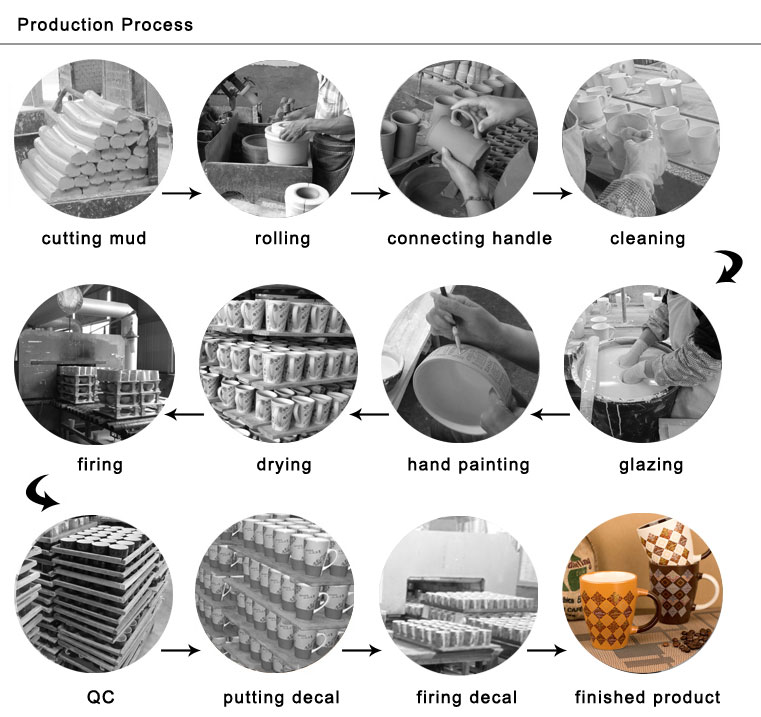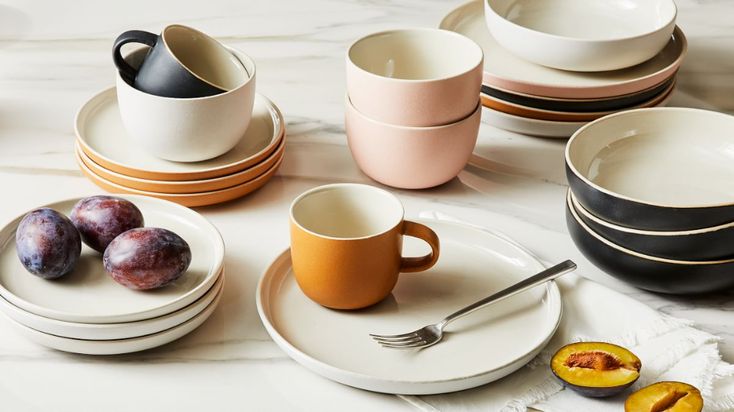
陶磁器の食器は、お手入れが簡単で、浸けても傷まず、汚れもつきにくいため、日常生活でよく使われ、人々に深く愛されている。陶磁器の食器は、その優雅な外観と優れた耐久性で、常に食卓で愛されてきました。同時に、めまぐるしい現代生活の中で、電子レンジは数え切れないほどの家庭の台所に欠かせない家電製品のひとつとなった。電子レンジがもたらす便利さを享受する一方で、しばしば口にされる疑問がある。
電子レンジにおけるセラミック食器の安全性を探ることは、日常生活の利便性と安全性に関わるだけでなく、材料科学、食品安全性、消費者教育など、さまざまなレベルに関わってくる。これらの知識を正しく理解し、応用することで、潜在的な危険を回避することができる。このブログでは 金華セラミックス が答えを見せてくれるだろう。
セラミック素材の概要
セラミックスは、食器の分野では最高の素材とされている。最高のセラミックスは、その弾力性、強度、透明性、浸透性で知られています。もろく割れやすいように見えますが、実は固いのです。このカオリンという素材は、通常華氏2,372度以上の高温で粘土を加熱して作られるため、食器はガラスのように丈夫で耐久性があり、そのセラミック食器の耐久性を保証している。
陶磁器は長い歴史を持つ人工素材であり、その多様性と美的価値は人類の文明において極めて重要な位置を占めている。電子レンジにおけるセラミック食器の安全性を論じる前に、まずその基本的な定義とマイクロ波との相互作用の原理を明確に理解する必要がある。
セラミックの定義
セラミックスは、無機非金属材料を成形し、高温で焼成した固体材料の一種である。通常、高い硬度、耐熱性、耐食性などの特性を持つ。セラミックスの主成分は、中国やフランスのリモージュ地方原産のカオリン。高温で焼成され、きめが細かく、透明度が高く、歯切れのよい音がする。一般にセラミックは高品質とされ、食器など様々な用途に適している。
セラミック食器製造工程
陶磁器食器の製造工程は一般的に、原料の選択、粉砕、混合、成形、乾燥、釉薬、焼成の段階を含む。陶磁器食器の種類によって、原料の選択、焼成温度、釉薬の使用などに大きな違いがあります。これらの違いは、密度、硬度、耐熱性、マイクロ波透過性などの物理的・化学的特性を直接決定します。

セラミック食器と電子レンジの相互作用
セラミックスが電子レンジで安全に使用できるかどうかについては、まず電子レンジの動作原理とセラミックスのマイクロ波相互作用特性を理解する必要があります。
マイクロ波の基本概念
マイクロ波とは、周波数が300MHzから300GHzの電磁波を指す。この周波数帯の電磁波は特殊な透過力を持ち、多くの非金属物質を透過できるが、水を含む物質には吸収される。電子レンジはこれを利用して食品を加熱する。
電子レンジはどのように食品を加熱するのか?
電子レンジのマグネトロンはマイクロ波を発生させ、それが庫内に均一な電磁場を形成する。食品中の水分子は極性分子であり、プラスとマイナスの電荷中心は重ならない。マイクロ波電界の作用により、水分子は急速に回転して互いに衝突し、発生した運動エネルギーは熱エネルギーに変換され、食品を加熱する。このプロセスが食品の内部から始まり、外部に広がることで、高速かつ効率的な加熱が実現する。
様々な材料によるマイクロ波の吸収と反射
セラミック、ガラス、プラスチックのような非極性物質は通常、加熱されることなくマイクロ波を通過できるが、水を含む極性物質はマイクロ波のエネルギーを吸収して発熱する。金属材料はマイクロ波を反射するので、電子レンジには入れられない。容器の材質によってマイクロ波の吸収・透過能力が異なるため、食品の加熱効率や安全性に影響する。

電子レンジにおけるセラミック食器の安全性分析
電子レンジに適した安全なセラミック食器は、以下の条件を満たすものでなければならない:
- 金属製の装飾や縁はありません:金属は電子レンジの電波を反射し、火花を散らしたり、電子レンジを破損する恐れがあります。
- 均一な材料分布:均一な材料は、マイクロ波が均等に浸透し、局所的な過熱を避けるのに役立ちます。
- 有害な顔料を使用していません:顔料の中にはマイクロ波照射により分解したり、有害物質を放出するものがあります。
セラミック食器が電子レンジで使えるかどうかを判断するには?
- 製品のラベルや説明書を確認してください:メーカーは通常、その製品が電子レンジでの使用に適しているかどうかを表示しています。
- 簡単な試験方法の紹介を行う:セラミック・ボウルと少量の水を電子レンジに入れ、1分間加熱する。ボウルが温かくなるだけで熱くならない場合は、電子レンジのエネルギーをあまり吸収していないことを意味し、このセラミック・ボウルは比較的安全であることを意味する。逆に、セラミック・ボウルが非常に熱い場合は、電子レンジでの加熱を避けるべきである。このテストは慎重に行い、火傷やその他の事故を避けるため、安全な操作手順を必ず守ってください。

セラミックスと他の素材との比較
セラミックスとガラスやプラスチックなどの一般的な電子レンジとの比較:
- ガラス耐熱ガラス(ホウケイ酸ガラスなど)は、電子レンジでは非常に安全な選択肢である。マイクロ波を吸収することもなく、有害物質を放出することもない。透明度が高く、食品の状態を観察しやすい。しかし、セラミックに比べ、急激な温度変化で割れやすいという欠点がある。
- プラスチックすべてのプラスチックが電子レンジでの使用に適しているわけではありません。プラスチック容器の底に「microwave safe(電子レンジ対応)」または関連マークがあるものを探す必要がある。これらのプラスチックは高温に強く変形しにくいが、長時間の使用や高温下では微量の化学物質を放出する可能性があるので、注意して選ぶ必要がある。
各素材の長所と短所のまとめ
- セラミック:美しく耐久性に優れているが、金属製の装飾や凹凸のある素材による安全性の問題に注意する必要がある。
- ガラス:安全で透明で観察しやすいが、温度変化に敏感で割れることがある。
- プラスチック製:軽くて便利だが、化学物質の放出を避けるため、電子レンジの安全レベルに注意する必要がある。
結論
陶磁器食器の発展は長い過程を経ており、多種多様なカラフルな磁器食器が人々の様々なニーズに応えている。陶磁器は一般的に電子レンジ用食器として安全であり、特に金属装飾がなく、材料が均一に分布しているという基準を満たしている場合は安全である。重要なのは、正しく選んで使うことであり、電子レンジの透過性に影響を与えたり、安全上の危険を生じさせたりするデザインや素材を避けることである。
材料科学の進歩に伴い、安全性、耐久性、環境保護の面でより多くの利点をもたらす可能性のある、新しいセラミックやその他のマイクロ波に適した材料が絶えず登場しています。従って、消費者にとっても製造業者にとっても、セラミック業界の新たな発展に目を配り、最新の安全基準や推奨事項を理解することが同様に重要です。製造業者は、常に最も安全で最適なセラミック食器製品を作ることができるよう、こうした情報を知っておく必要があります。
金華セラミックス は、最も消費者に優しい陶磁器食器を生産することを約束し、常に業界の動向と最新の技術に注意を払い、パートナーに最も競争力のある価格競争力のある卸売陶磁器食器を提供します。 ここをクリック をご覧ください。 卸売陶磁器食器 シリーズを開発しました。将来、陶磁器の食器は、より効率的で、より便利な日常使いになると信じています。より多くの情報のための私達に連絡する歓迎!


